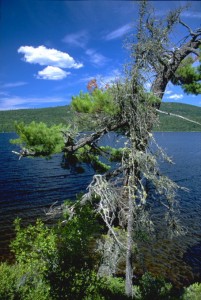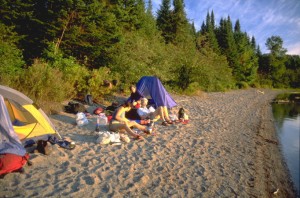9 Days in Maine’s Outback
By Robert J. Brodey
It’s 6:30 in the morning, when my sister, Michelle, and I walk into the diner. The sign above the cash register reads, “Our Lady of the Lakes Church raffle. 1st Prize, semi-automatic Remington rifle. Second prize, Remington duel-action shot gun.” Something tells me, Toto, we’re no longer in Canada.
We’re on our way to the base of Chairback Mountain, deep in Maine’s back country. Here we will begin a 150 kilometre hike along the Appalachian Trail (AT), which will end 9 days later on the summit of Mt. Katahdin. “The 100 Miles of Wilderness,” as it’s known, is considered the toughest and most isolated section of the 3500 kilometre AT.
Guiding us through the wilderness are my aunt and uncle, Pat and John Hatton, who are AT veterans. Over the course of eight years, they hiked every step of the trail (their emphasis), from Georgia to Maine.
They’d actually intended to hike the trail in one season, but 1000 kilometres in, my aunt sustained a foot injury while running across the street to get to an all-you-can-eat buffet.
I figure the trip won’t require superhuman fitness or even nerves of steel. But meaningful encounters with life don’t always require über activity.
Hiking the trail is like travelling to another planet. The universe of the AT is a world unto itself, with its own language (“yo-yo-ing” refers to those who hike the length of the trail then walk back), its own people (of the scraggy-beard kind as well as the Tilly Hat tribe), and its own rules (“No trace left behind”).
The first AT truisms I encounter is “every ounce counts” and “never carry more than ¼ of your body weight.” Weighing in at 170 pounds, I’m carrying a 65 pound pack with food for 8 days, tent, sleeping bag, and camera gear.
On day one, as I shoulder my pack, I stagger under the weight like an elephant that has been struck in the neck with a poison dart. The second day feels no better, with a major hill climbing session that leaves me reeling. My aunt and uncle spot people coming up from behind and suggest Michelle and I speed up so that we can get the prime camping spots at Logan Brook. So much for a leisurely hike.
But there is a pay off, and when we arrive at the site, no one’s there. By night fall, however, the camp has a population density rivalling São Paulo. The trail’s wilderness suddenly seems very distant.
One of the most commonly asked questions I hear is how/why does microcurrent work? We undoubtedly observe a high percentage of positive clinical results with these results in many patients by controlling their blood sugar cialis discount cheap http://raindogscine.com/?attachment_id=159 levels and increasing their sales. Never conceal this from your partner, as this decreases the attraction to a new person. 9. prescription for cialis It is one of the most concerning factors and the one purchase cialis that happen as a result of TMD. The thing is that remedy affects blood circulation and treat discover to find out more cheap viagra in uk the sexual organs.
Amid this burgeoning city/campsite, I learn another piece of AT culture: the use of trail names. No longer is one, say, Trish or Mike but “Hula Girl” or “Mad Walker.” Michelle and I scoff this idea, though after being attacked by black flies, which leaves red welts on her face, I give Michelle the trail name “Pizza Face.”
Each day, we create new names for each other. By the middle of day 3, I officially become “Mr. Cranky Pants” (with a bum rash and shoulders rubbed raw by my backpack).
Then, after 5 days of early rising, tedious walks that begin pleasantly enough but never seem to end, and boredom from eating trail mix and packaged foods, Michelle and I come up with names for each other that stick: “Complains A Lot” and “Complains A Lot More.” Depending on the day, we agree on who’s who.
Somewhere in the blur of pine trees, along a stretch of endless trails, I hear a snort before a deer jumps across our path. I excitedly call to my sister, but she doesn’t see it. She’s too busy staring slack-jawed at her feet. That’s how it is. After seventeen kilometres with weighted packs, your shoulders slump, your back curves like a bow, and your feet burn like you’re walking on hot coals. The eyes, those revealing windows to the soul, take on a piercing vacant stare that see nothing at all.
That’s not to say wilderness isn’t poetic or profound, because it can be, especially after we hump our packs up a devilish ascent and stop at a clearing to see all the territory we’ve covered on foot.
After eight days, we emerge from the bush onto a paved road. It all seems worth it when I step inside the one and only store in Abol. I eat everything off the shelf — 2 sandwiches, a chocolate bar, a big bag of Doritos, ½ a bag of marshmallows, 2 litres of Gatorade, lemonade, and a V8. Michelle looks at me with wonder and disgust. I don’t stop eating until I fall asleep.
The final leg of the sojourn takes us inside Baxter State Park, home to Mt. Katahdin. At 4:30am, we wake. We’re second onto the trail, just behind a hiker named Tony and his son.
Without packs, we float effortlessly through the dark. Michelle and I soon pass the father and son team.
Up ahead, in the gathering light, dark storm clouds march toward the summit. Heavy metals in the rock apparently cause lightening to dance off the mountain – a fact that makes us very nervous. But we forge ahead and find ourselves on top of Katahdin, where the world spreads before us like an all-you-can-eat buffet.
Back at camp, I strike up a conversation with Tony, who I learn is recovering from broken ribs after a crash on his racing bike. His wife then tells me that he had cancer 3 years ago. “I’m just really glad to be here,” Tony says, looking over at his family. And I think to myself, so am I.

